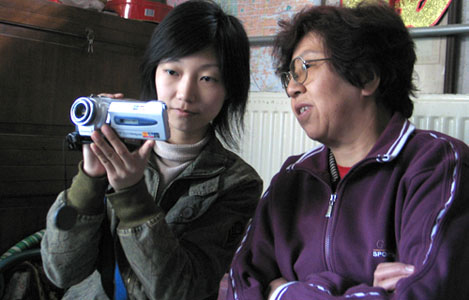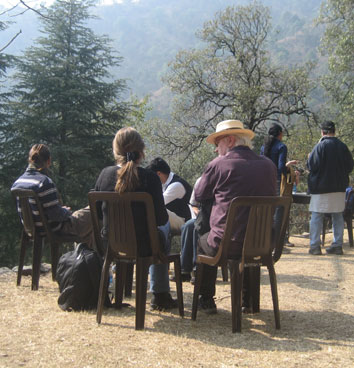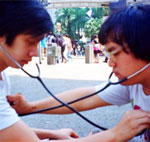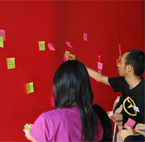beijing
June 2006 saw Beijing in a flurry of preparation for the olympic games, not only the grand new stadiums being constructed but what seemed to be the rest of the city also under reconstruction. Streets were being resurfaced, old buildings knocked down, new modern ones put in their place, even the forbidden city seemed to be undergoing a face lift.

The major stimulus to visit Beijing at this time was the
opening of Synthetic Times, the international exhibition and
symposium of new media arts at the National Art Museum.
synthetic times

Synthetic Times - Media Art China 2008 was held at the National Art Museum of China. It appeared to be a land mark occasion for media arts in China, the first time that such an event had taken place on this scale and within a historic public institution. The exhibition presented over 50 works from international artists, along with screenings, lectures and symposium program. The event included contributions from major media art organizations and contemporary art insitutions including V2, eyebeam, Tate, MOMA, MAAP, Ars Electronica, Transmediale, FACT, ZKM, but with little Asian representation.
 The works were divided into 4 categories and designed to provide
an overview of both media art pioneers and recent developments.
The works were divided into 4 categories and designed to provide
an overview of both media art pioneers and recent developments.
Human condition under influence of technology
Beyond body examined the human condition under the influence of technology, how the extended body is formed and how this facilitates a merge of life and media.
Emotive Digital further examined this man/machine relationship and questioned the ability of technology to be affective and affected.
Recombinant Reality proposed the construction of hyperreality through media technologies, in which virtual and physical, imaginary and real become merged in our perceptions. Here, There and Everywhere investigated the perception of oneself in constructed time and space, in which we must reassess our relationship with society, geography and history.
However this was not an opportunity to learn of media art in China, with only 2 Chinese artists presenting in the whole exhibition, its purpose was to introduce the international media arts scene to Beijing, but with little local contextualiztion. Works were presented on an impressive scale, highly visually stimulating and accessible to a general audience while also including more conceptually/critically challenging exhibits.
zhang ga

Zhang Ga is curator and critic based in New York city. He was the director of Synthetic Times, the major media arts exhibition in the national museum, Beijing. This is the fourth large scale exhibition of media arts which he has curated/directed in Beijing. His activity has made a significant contribution to deepening the understanding of media arts in China. He comments that the approach to new media before 2003 had no broader understanding than screen based, animation, computer graphics or video. His first attempt to inform artists and audiences of wider media practices was through an exhibition presenting documentation of works from major international media art festivals such as ARS electronic, along with the participation of over 50 international universities. ‘ Leading the edge’ was the first international exhibition and symposium for media arts in Beijing, also known as Millennium Dialogue. http://newmediabeijing.org/md2004/ It was established in particular collaboration with the institutes ZKM and V2 to introduce new media art to China.
He went on to curate ‘In the line of flight’ 2005 which examined the urbanization process and media technology’s role in this. http://newmediabeijing.org/md2005/ which included further cooperation with organizations such as ICC and BANFF center. This was then followed in 2006 with CODE:Blue, which took on a discussion of inward looking and outward looking culture and how code as a universal borderless language can be used as a metaphoric link between these different perspectives, reviving the popular 80s discussion on the cultural condition of China. http://newmediabeijing.org/md2006/ This event involved further collaborations with Art Center NABI and Transmediale and the Chinese selection of the exhibition went on to be presented at ISEA 2006 as the 'container culture' project.
2008 Synthetic Times is a result of 5 years of evolution presenting an overview of the international media art scene with works from all major festivals encompassing established figures in media art history and emerging talents. Synthetic Times is curated around 4 thematics and offers a comprehensive approach to the presentation of international media arts to a local audience. The exhibition is taking place in Beijing’s prestigious National Art Museum, a pioneering gesture to present media arts in a historic and highly public space. The curation of the project therefore required a great sensitivity to the general audience who would be engaging with the program, having to ensure accessibility, with approachable works which would not alienate the general public. The exhibition is on a highly impressive scale with works from famous artists from all over the globe, providing a valuable insight into the global media arts scene.
We spoke of the kind of impact the exhibition could have on Beijing and wider China, in which Zhang Ga expressed a hope that it would provide stimulus for the arts community and also raise the interest of general audiences to increase understanding of this art form and instigate further activities and research within the field. We discussed the development of media arts in China and what provision is being made for its progress. It is currently an economic strategy of China to promote digital technology as a sustainable economy. Therefore many educational institutions are focusing on creative industry which is undergoing rapid development but allows little time for critical reflection. Many young artists are using off the shelf technology with very little theoretical or critical questioning. Many have a digital vocabulary and are generating creative content but there is a need to combine this with a critical perspective, in what Zhang Ga describes an advanced warning system. He has been involved in publishing a series of books on media art theory and history in Chinese to provide an important resource for students and young artists to gain a more critical grounding in the field.
Zhang Ga suggests that media arts in China has not yet developed its own language, it is based on mainly imported material, which is yet to be fully digested. There have been some pioneers of media art in China, for example Zhang Peili who began with producing video works and extended his practice into interactive installation and is now active as a curator. Also highly established Chinese artists such as Xu Bing have also begun to utilize technology in their works, but with out concern to emphasise it as new media. Zhang Ga points to many new directions that can come from China and is excited to see the developments.
Zhang Ga is also active as an artist. From 1994 he has been engaged with computer based works, in particular net art projects, which he viewed as a utopian ideal which could run parallel to the museum, or challenge the museum. He established the Netart Initiative in New York in the late 90s, which organized a monthly salon and live net broadcast over 4 years and has been highly active in various other projects to provide artists and curators with a theoretical and critical framework in the approach to media arts. One of his most famous projects has been ‘The People’s Portrait’ which is referred to as a ‘global networked public art project’. With globally distributed and networked nodes in public spaces passersby are able to upload their image to the network which is then displayed in sequence on urban screens throughout these nodes, offering insight into different locales globally.
http://agent.netart-init.org/exhibitions/
8gg

8GG are an art and design duo, Jia Haiqing and Fu Yu, who have been working together for over 10 years. Their work spans the cross section between experimental media art, performance, music and commercial design. They began their career in web design, designing for commercial companies but also experimenting with this new medium in the late 90s, manipulating its properties and investigating the notions of interactivity. The artists had a strong interest in music, especially electronic which in turn led them to investigate the potential of the computer to make music which led them to media arts. In fact some of their first creative projects for the web were in the form of music visual games.
Their first client for their design practice was Apple in 1999 and they have since worked with Microsoft, Nike and Addidas. From 2000 they began to make events in galleries and present exhibitions. They feel comfortable to move between contemporary art and commercial design and encourage cross over between them. They work in a range of media including photography, video, web design, performance and installation, and are developing an increasing interest in public space and invisible computing. Their practice has lead them to presentations in various countries in Asia and Europe including France, Germany, Switzerland, UK and Japan.
From 2002 they have focused on using audio/visual technology as an instrument in live shows. An exchange project initiated by the British council created a significant opportunity for 8GG and offered them vital new exposures. They joined with the well known Brtish audio-visual group DFuse in a collaboration which produced a whole new body of installation, video and audio-visual performance work which has gone on to tour internationally. They have gone on to collaborate with many other groups and individuals. They have been working with Yan Jun in the production of the Mini Midi Festival for experimental music and have realized new works together. They have also been working with experimental theatre director wang jian wei creating audio and moving image for his productions, which have also toured internationally and were recently presented at the Pompadieu Centre. They were about to return to France when I met them, to work with a dance company.
Their practice has proved very versatile and enjoyed success in many different fields. They have gone on to explore in more detail ideas of interactivity in these practices. In a project for adidas they designed an interactive shop front display in which moving image responded to the viewer. By blowing on the display the clothes of a figure were blown away. They have also joined an art project for Nike in which they created a music installation which the audience could control. They presented the work ‘Refraction’ in the 2004 Shanghai Biennale, an interactive installation in which the audio and visual were created by the audience. This interest in interactivity is again shown in their recently realized work in Manchester called ‘VIP room’. The room is filled with 9 chairs in front of a projection, when the chairs are sat on the viewer can mix the video and change order and rhythm of the audio/visual.
In many of their works they prefer not to emphasize the conceptual framework but to stress the experience and response of the audience, to provide stimulation for the viewer. Their live presentations are on an impressive scale which immerse the viewer in their images and music. These large-scale performances have included Cologne 2007 experimental music triennale and a presentation in 2004 in Zurich involving 9 projections. They also recently presented 'The Air been broken' at Manchester Urban Screens conference as an out door audio-visual performance, in which they emphasised reacting to the moment, at the time the large urban screens were full of news of a new prime minister, and they used this footage to create what they describe as a 'news dance' taking real time information to create new forms and meaning.
gogoj

Gogoj (Jie Sheng) is a young artist who studied media arts in Strasbourg. Her studies in France gave her a new perspective on art and gave her a clear theoretical/conceptual grounding. It also provided her with many cultural experiences and certain freedoms she had not experienced in China. On returning to China she encountered quite a shock and how drastically society had changed over just a few years, in particular the huge power of youth. Much of her work comments on this shift in society and change in values brought through new popular culture. Primarily working with video and sound both as installation and live performance she is interested in investigating the gap between reality and the mirage through images.
Her works include:
Chinese Bonsai original sound 2005 was a particular comment upon this new phenomena which she found upon her return to China. A new presence which was disquieting for her.
Push 2007
Is a simple animation in which one figure mechanically pushes a sequence of figures one after the other into line, like a factory assembly line, until finally the passive figures push back. The work is designed for 5 screens and was presented at c5 art, Beijing.
Dancing Bo 2006
Also reflects a concern with rhythm and movement. In a comment on Chinese youth, a boy with illuminated poi dances continuously to an unknown rhythm, which only he can hear on his headphones.

Entice-confuse 2007
Contrasts various scenes, in the first section crowds at temples and crowds in shopping centres are juxtaposed with scenes of naked women, attempting to sexually entice the viewer. The next section presents a strange scene of black magic in which a woman is transformed into a man.
When I met Sheng Jie she was planning a new video installation in which the viewer would be faced with their own image, constantly shaking, like an earthquake, and echoed by the physical shaking of the actual space too. She aims to make the audience very uncomfortable and to propose a comment on the rush of redevelopment that China is now gripped with.
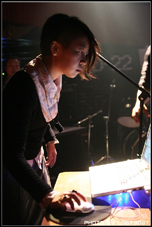 jie
sheng is also very active in the experimental music scene and often
to collaborates with musicians and other sound artists in creating
audio/visual elements for live performances.
jie
sheng is also very active in the experimental music scene and often
to collaborates with musicians and other sound artists in creating
audio/visual elements for live performances.
2/2008 ‘THERE IS NO I IN TEAM’, ISIS Arts and /sLab present , Newcastle, UK.////////// 11/2007 microwave international new media arts festival, HongKang./////////// 9/2007 Frishzelle/early winds festival 2007, sound & video performance. ////////// 6/2007 BorderLine Festival, platform, beijing china.//////////// 5/2007 INFANTIZATION, Shanghai Art Museum.//////////// 5/2007 French Urban & Electronic Music in Croisement(s) Festival , beijing.//////////// 4/2007 2007 Beijing 798 Art Festival.//////////// 12/2006 exhibition “eyes on” Beijing -Shanghai./////////// 10/2006 The Second China Songzhuang Culture Art Festival.///////////// 10/2006 ART BEIJING 2006, youth art zone.//////////// 10/2006 festival ‘19es instants video’ , paris,marseille, fance, PARAGUAY – Asunci n (America latin)./////////// 9/2006 video + sound in ‘watreland kwanyin’, beijing.////////// 9/2006 ZKM (centre for art and meidia), ‘totalstadt.beijing case’, karlsruhe./////////// 4/2006 visonic vj show, beijing./////////// 1/2006 'the window on the street' Petite Galerie-A tre Sanit-Maclou, Rouen,france.///////// 11/2005 Film Alsace, Strasbourg,france.///////////// 3/2005 "TOP POPULAR DRUGS" La Chauffrie, Strasbourg.////////// 2/2005 "COW COW" laitrie, Strasbourg.////////// 12/2004 "Mars person" art video night in paris.////////// 7/2003 studio open days,Strasbourg
yao bin

Yao Bin studied at Hiroshima City University, Japan and then practiced as a media art curator for several years in Tokyo. On returning to China he continued to promote media and experimental arts and founded 11-art.com Cubic Arts in 798 District where he would present exhibitions, live events and lectures. He invited many international artists to present in the space and give audiences in Beijing an opportunity to see new practices and approaches to art. The space ran for two and a half years and was the first of its kind for new media art in Beijing. However a lack of funding, the commercialization of 798, soaring rent prices and a wish to do other things led to the space being closed. Yao Bin must face the question of how it is possible to make money through media art, to make self-sustaining and to bring it more into society.
He was on the advisory board for the Jury of Ars Electronica Grand Prix for Digital Communities this year and told me he was currently investigating digital networks linked with the countryside and rice making, nothing related to art. In fact a Chinese project was the final winner of this prize. ‘1kg more’ is a project aimed at improving education resources for children in impoverished rural areas of China, asking tourists and visitors to China to bring one extra kilogram in text books/literature etc. in their luggage which then can be sent to these regions when arrived in the country.
In addition to being a curator and critic, Yao Bin is also active as an artist too. Originally he studied sculpture and became increasingly interested in sound installation and software programming. He is particularly interested in real-time processes, both in terms of live performance and interactive installation.
In the last two years Yao Bin has seen the media arts provision in China dramatically increase, for example the Shanghai government have begun to support media art, trying to establish the city as a media arts centre, shown in particular through the initiation of 'e-arts', a large scale festival for media art. Also he comments that there has been a particular impact of the Olympics, bringing media into the city. But he is sceptical of the continuity of this support and points out that although in video art Chinese artists have a growing personality, media art is still in very early stages of development here, and has yet to form direction and identity.
Yao Bin was working on a project for E-arts when I met him. This project ‘Rhythm Up’, is an installation set in an outdoor public space by a subway station. The work emits sound which reacts to the movement of people through the space and captures their trace through it, the sounds gradually evolve throughout the exhibition period as a record of the movements which have taken place.
However Yao Bin is now departing from his concentration on pure media art and investigating what media is itself. He has now commenced a number of projects investigating the use of plants and organic/biological matter as a medium, commenting that he wants to change real things, to work with physicality, something which is often lost in the intangible field of media arts.

http://music.columbia.edu/organism
yan jun

Yan Jun is a phenomenally hard working artist, poet, musician, curator, producer and organizer, whose activity is highly inspiring, but his relaxed, modest attitude puts one immediately at ease. With such a wide range of activities and outputs it is difficult to know where to start. Perhaps to introduce some of his personal works. Yan Jun has been experimenting in the field of sound art and new music for many years. He has explored many methods and practices including noise, spoken word, electronics etc, but a particular focus has been upon field recordings. He has recently been visiting to many rural areas in China and making field recordings, then producing mini cds which he then sells/gives to the local people living there. It is an interesting feedback system, in which Yan Jun replays the sounds of the everyday, but with a new unfamiliarity. Yan Jun works across so many roles that it is of course hard to catergorize his activity, he has a deep understanding of contemporary art, but is concerned with how exclusive its institutions can be. In an exhibition in Sweden presenting the works of young Chinese artists in a museum space Yan Jun presented a sound installation in the garden using coincidental sounds made from field recordings in the area. This very unobtrusive work was intended to enter the audience subconsciously without proclaiming itself to be art. Yan Jun has also made pioneering projects in his role as curator/organizer. For the last three years he has been running an event every weekend Waterland Kwanyin which presents experimental music and sound art. He is also director of the annual mini midi festival.
Yan Jun is very excited by the new possibilities of promoting and sharing music offered by the internet and comments that it has radically changed and diversified the music scene. He applauds the openness of young people who are sharing music and allowing new alternative cultures to emerge. He asserts the power of the internet to bring communities together and to destroy systems of control. Particularly in China where the government heavily controls the release of film and music, the internet allows a gateway to many cultural products despite the great firewall. Yan Jun comments that sound artists are meeting and collaborating through the internet, they are releasing their work on the internet. He is so much impacted upon that he built a festival around the internet, with over 500 hits a day.
Yan Jun is passionate about giving new opportunities to young people and offering exposures to new forms of expression. He is a prolific writer as a critic, reviewing new releases, gigs, and commenting upon the progression and history of experimental music in China and also internationally. He organizes many events to generate discussion and debate around music forms. Recently he has promoted a series of film programs to initiate discussion with regard to the relationship between sound and film. Yan Jun comments upon the strong ideology or identity which is associated with music. His own practice and the movement of experimental music in china has evolved from the impact of rock music in the 90s, which offered many people, especially youth, another way of life, another culture and the development of the underground scene which was initially based upon alternative identity rather than just music.

event structure

Yang2 and aaajiao are two young artists collaborating under the name of Eventstructure. They have realized a number of large scale projects together and also have a very active individual practice. A number of these projects have been realized for e-arts Shanghai’s annual media art festival. In 2007 they presented a real life version of pacman in a public space in Shanghai, in which a huge maze was created and a camera suspended 10m high captured the movements of the participants. Their project for the next e-arts festival is called ‘Horizon’, a network based project is a large scale multiscreen public installation which utilizes google earth to present horizons from all over the world which the audience can control with a giant mouse.
Yang2 has also done much to support Dorkbot Beijing. Dorkbot is an international movement which brings people together interested in experimenting with electronics and finding new creative uses for them. The Beijing group consists of a core of 20 people and was first initiated by a university student. They now meet regularly at the central conservatory for music and have engaged in a number of events together, including a max/msp workshop/demonstration, an example of sharing different skills amongst the group.
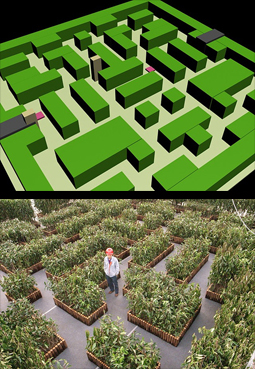
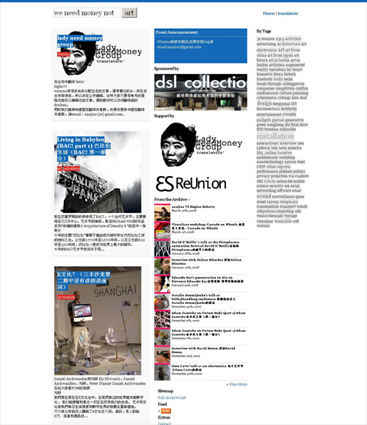
Aaajiao also has many other projects which he is involved in. One of the most well known is 'we need money not art', which takes the popular media art blog 'we make money not art' and translates it into Chinese, while also creating local content too. This allows access to Chinese artists and audiences to information about international media arts and also developments within the country. It is an invaluable resource, much needed at a time when the internet is overly dominated by the English language. He has also created a web resource cornersound.com for sound art in the region. He is very concerned with creating networks between artists and creating forums for exchange and dialogue between them in order to support each other and distribute information.
http://www.eventstructure.com/
ou ning


Ou Ning is another multi-talented practitioner with many roles as curator, organizer, researcher, artist, critic etc. He is also highly motivated to offer opportunities to young artists and designers in China. One of his major projects is ‘Get it Louder’ a showcase of emerging talent in art design which takes place every two years. He comments that many young practitioners have studied abroad and on their return to China they have difficulty finding an output for their work, they are active underground but need a bigger platform, which is what Get it Louder provides. The event includes fine art, film, design, fashion, architecture etc, and last year was presented on every floor of one of Beijing’s major shopping malls. To build the profile of the event and offer new exposures to the Chinese audience, international artists are also included in the program. Last year a showcase was made of artists/designers from UK and Japan. Furthermore he encourages young students and artists to organize their own exhibitions in their homes as part of the event program, this is called Homeshow which allows members of the public to view art in personal spaces and engage directly with the artists. Last year there was also a special mobile sound event sponsored by minicooper. In 'Moving Soundscape' 20 sound artists made field recordings around streets surrounding the exhibition area. The audience member was able to board a minicooper and select a journey, recordings of which they could hear through the car stereo system as the car was driving through those exact streets.

In March he organized The Nike Dunk·Be True exhibition at 1918 Gallery, Shanghai. This was part of an internationally touring exhibition of Nike’s dunk shoes, Ou Ning organized the accompanying artistic program which included 8GG, Ying Liang, Lei Lei, Zhou Hongxiang, Open Architecture and aaajiao. Aaajiao presented an interactive work in which sensors inside shoes manipulated navigation of google earth.

Ou Ning is also highly involved in urban research and has initiated a number of projects which respond to urban planning and development. One of these projects is Da Zha Lan. Beijing has seen a huge development over the last few years, whole areas reconstructed, remodeled to promote a modern look, which saw particular acceleration for the Olympic Games. But whole areas of historic buildings, personal histories and memories are being wiped out too in this process. People who have lived all their lives in these places are being evicted and told to live elsewhere, while their very livelihood is built upon that specific site. Da Zha Lan is one such area, a hutong with a long history and residents very much attached to their neighbourhood. The project attempts to draw attention to the plight of its residents and offer certain forms of resistance which they can engage in.

This examines a ‘slum’ area in Beijing, very close to Tiananmen Square, which is the focus of a government project to redevelop the district. The whole neighborhood currently appears to be a construction site, but there are people living there and trying to continue their businesses and everyday activity. Ou Ning and his collaborators have been working with the local residents for a concerted period of time to investigate the difficulties the local people face, their deep attachment to the place where they live and work, and how this is threatened by ‘regeneration’. Using basic media technologies such as digital camera, video camera and sound recording equipment the locals have sought a new empowerment in which they can record the process of destruction and construction around them in a unique form of protest and personal storytelling. One local man, a restaurant owner in particular was inspired by the project and gradually took on the role of a local leader in voicing opposition to the regeneration of the area. He used these digital technologies as a method of opposition including creating a blog and regularly uploading photos and other documentation of this resistance.
The social motivation of the project is highly engaging but also raises various problematics, questioning the relationship between the artists and the residents, the different agendas at play and the long term impact of such activity.
Ou Ning stresses that media technology should have impact on the political situation not just be used as entertainment, it has the potential to be used as a weapon in a social movement. The digital camera and the internet have a social function and can express political ideas. The project has also brought international attention to the issues people living in this area are facing, a documentary film 'Meishi Street' has been widely screened and exhibited in various international festivals.
Ou Ning’s next major urban project is surprisingly taking place in an isolated rural village in the yellow mountain region near Shanghai. Many rural areas in China are suffering with decline as many young people move to the city, leading to public life in the village dying. Ou Ning wants to attract people back to the village and connect it with the urban network. Examining rural culture and forming collaborations between city and village residents he aims to bring an urban network to the village.








